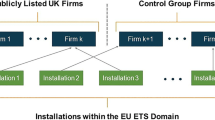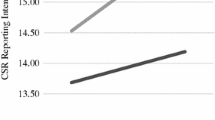Abstract
Though interfirm collaboration on carbon emission reduction, the cross-enterprise flow of emission reduction resources and improved efficiency in greenhouse gas reduction can be realized. Especially in the context of big data, enterprises can find suitable partners for emission reduction faster and more accurately through interfirm collaboration. However, similar to other cooperative modes, revenue allocation is the key to ensuring the stability of the collaborative emission reduction system. Based on the premise of carbon trading, this paper discusses revenue allocation among enterprises participating in the collaborative emission reduction process under complete information in a big data context. Specifically, we constructed a Shapley value analysis model of revenue allocation for interfirm collaboration on carbon emission reduction, and amended this model with investment cost and risk-bearing. Consequently, this research provides not only a theoretical basis for solving the problem of revenue distribution in the process of collaborative emission reductions among enterprises but also a theoretical guide for enterprises countermeasures following the completion of China's future carbon trading mechanism.
Similar content being viewed by others
Notes
Data source: http://huanbao.bjx.com.cn/news/20200303/1049951.shtml.
Data source: https://www.in-en.com/article/html/energy-2284546.shtml.
References
An, Q. X., Wen, Y., Ding, T., & Li, Y. L. (2019). Resource sharing and payoff allocation in a three-stage system: Integrating network DEA with the Shapley value method. Omega-International Journal of Management Science, 85, 16–25. https://doi.org/10.1016/j.omega.2018.05.008
Atat, R., Liu, L. J., Wu, J. S., Li, G. Y., Ye, C. X., & Yi, Y. (2018). Big data meet cyber-physical systems: A panoramic survey. IEEE Access, 6, 73603–73636. https://doi.org/10.1109/access.2018.2878681
Bahinipati, B. K., Kanda, A., & Deshmukh, S. G. (2009). Revenue sharing in semiconductor industry supply chain: Cooperative game theoretic approach. Sadhana-Academy Proceedings in Engineering Sciences, 34(3), 501–527. https://doi.org/10.1007/s12046-009-0018-9
Benjaafar, S., Li, Y. Z., & Daskin, M. (2013). Carbon footprint and the management of supply chains: Insights from simple models. IEEE Transactions on Automation Science and Engineering, 10(1), 99–116. https://doi.org/10.1109/tase.2012.2203304
Burdyny, T., & Smith, W. A. (2019). CO2 reduction on gas-diffusion electrodes and why catalytic performance must be assessed at commercially-relevant conditions. Energy and Environmental Science, 12(5), 1442–1453. https://doi.org/10.1039/c8ee03134g
Cai, W., Lai, K. H., Liu, C. H., Wei, F. F., Ma, M. D., Jia, S., et al. (2019). Promoting sustainability of manufacturing industry through the lean energy-saving and emission-reduction strategy. Science of the Total Environment, 665, 23–32. https://doi.org/10.1016/j.scitotenv.2019.02.069
Chauhan, S. S., & Proth, J. M. (2005). Analysis of a supply chain partnership with revenue sharing. International Journal of Production Economics, 97(1), 44–51. https://doi.org/10.1016/j.ijpe.2004.05.006
Dabbagh, S. R., & Sheikh-El-Eslami, M. K. (2015). Risk-based profit allocation to DERs integrated with a virtual power plant using cooperative Game theory. Electric Power Systems Research, 121, 368–378. https://doi.org/10.1016/j.epsr.2014.11.025
Delbufalo, E. (2017). The effects of suppliers’ trust on manufacturers’ innovation capability: An analysis of direct versus indirect relationships. Production Planning and Control, 28(14), 1165–1176. https://doi.org/10.1080/09537287.2017.1350766
Ding, H. P., Guo, B. C., & Liu, Z. S. (2011). Information sharing and profit allotment based on supply chain cooperation. International Journal of Production Economics, 133(1), 70–79. https://doi.org/10.1016/j.ijpe.2010.06.015
Gao, E., Sowlati, T., & Akhtari, S. (2019). Profit allocation in collaborative bioenergy and biofuel supply chains. Energy, 188, 13. https://doi.org/10.1016/j.energy.2019.116013
Giurco, D., & Petrie, J. G. (2007). Strategies for reducing the carbon footprint of copper: New technologies, more recycling or demand management? Minerals Engineering, 20(9), 842–853. https://doi.org/10.1016/j.mineng.2007.04.014
He, J. J., Huang, Y. F., & Tarp, F. (2014). Is the clean development mechanism effective for emission reductions? Greenhouse Gases-Science and Technology, 4(6), 750–760. https://doi.org/10.1002/ghg.1448
Jiang, N., Zhang, L. L., & Yu, Y. G. (2015). Optimizing cooperative advertizing, profit sharing, and inventory policies in a VMI supply chain: A nash bargaining model and hybrid algorithm. IEEE Transactions on Engineering Management, 62(4), 449–461. https://doi.org/10.1109/tem.2015.2469684
Kimms, A., & Cetiner, D. (2012). Approximate nucleolus-based revenue sharing in airline alliances. European Journal of Operational Research, 220(2), 510–521. https://doi.org/10.1016/j.ejor.2012.01.057
Lehoux, N., D’Amours, S., & Langevin, A. (2014). Inter-firm collaborations and supply chain coordination: Review of key elements and case study. Production Planning and Control, 25(10), 858–872. https://doi.org/10.1080/09537287.2013.771413
Li, S. J., Zhu, Z. B., & Huang, L. H. (2009). Supply chain coordination and decision making under consignment contract with revenue sharing. International Journal of Production Economics, 120(1), 88–99. https://doi.org/10.1016/j.ijpe.2008.07.015
Li, T., Zhang, R., Zhao, S. L., & Liu, B. (2019). Low carbon strategy analysis under revenue-sharing and cost-sharing contracts. Journal of Cleaner Production, 212, 1462–1477. https://doi.org/10.1016/j.jclepro.2018.11.282
Li, Y. L., Wu, F., Zong, W., & Li, B. (2017). Supply chain collaboration for ERP implementation An inter-organizational knowledge-sharing perspective. International Journal of Operations and Production Management, 37(10), 1327–1347. https://doi.org/10.1108/ijopm-12-2015-0732
Lian, B., Chen, G. L., Wang, L., Cui, J. L., Yu, P., & He, D. K. (2020). A practical solution to clone problem in anonymous information system. Information Sciences, 516, 158–191. https://doi.org/10.1016/j.ins.2019.12.014
Liu, Q. L., Lei, Q., Xu, H. M., & Yuan, J. H. (2018). China’s energy revolution strategy into 2030. Resources Conservation and Recycling, 128, 78–89. https://doi.org/10.1016/j.resconrec.2017.09.028
Lv, B., & Qi, X. G. (2016). Profit allocation in collaborative product minor updates supply chain enterprises based on improved shapely value. Journal of Advanced Mechanical Design Systems and Manufacturing, 10(6), 11. https://doi.org/10.1299/jamdsm.2016jamdsm0088
Molina-Morales, F. X., Belso-Martinez, J. A., Mas-Verdu, F., & Martinez-Chafer, L. (2015). Formation and dissolution of inter-firm linkages in lengthy and stable networks in clusters. Journal of Business Research, 68(7), 1557–1562. https://doi.org/10.1016/j.jbusres.2015.01.051
Scheffran, J., & Pickl, S. (2000). Control and game-theoretic assessment of climate change: Options for Joint Implementation. Annals of Operations Research, 97, 203–212. https://doi.org/10.1023/a:1018940627463
Shi, Q., & Lai, X. D. (2013). Identifying the underpin of green and low carbon technology innovation research: A literature review from 1994 to 2010. Technological Forecasting and Social Change, 80(5), 839–864. https://doi.org/10.1016/j.techfore.2012.09.002
Tan, Z. F., Li, H. H., Ju, L. W., & Tan, Q. K. (2018). Joint scheduling optimization of virtual power plants and equitable profit distribution using shapely value theory. Mathematical Problems in Engineering, 2018, 13. https://doi.org/10.1155/2018/3810492
Urpelainen, J., & Van de Graaf, T. (2018). United States non-cooperation and the Paris agreement. Climate Policy, 18(7), 839–851. https://doi.org/10.1080/14693062.2017.1406843
Wang, L., & Hui, M. M. (2020). Research on joint emission reduction in supply chain based on carbon footprint of the product. Journal of Cleaner Production. https://doi.org/10.1016/j.jclepro.2020.121086
Wang, M. Y., Li, Y. M., Li, M. M., Shi, W. Q., & Quan, S. P. (2019). Will carbon tax affect the strategy and performance of low-carbon technology sharing between enterprises? Journal of Cleaner Production, 210, 724–737. https://doi.org/10.1016/j.jclepro.2018.10.321
Wang, Q., Wang, W., & Sohraby, K. (2017). Multimedia relay resource allocation for energy efficient wireless networks: High-Layer content prioritization with low-layer diversity cooperation. IEEE Transactions on Vehicular Technology, 66(11), 10394–10405. https://doi.org/10.1109/tvt.2017.2744600
Wang, Y., & Hou, G. S. (2020). How sticky information and members attitudes affects the co-innovate carbon emission reduction? Journal of Cleaner Production. https://doi.org/10.1016/j.jclepro.2020.121996
Wang, Z. H., Hu, S. Y., Zhang, B., & Wang, B. (2018). Optimizing cooperative carbon emission reduction among enterprises with non-equivalent relationships subject to carbon taxation. Journal of Cleaner Production, 172, 552–565. https://doi.org/10.1016/j.jclepro.2017.10.196
Wu, S. B., Gu, X., Wu, G. D., & Zhou, Q. (2016). Cooperative R&D contract of supply chain considering the quality of product innovation. International Journal of Simulation Modelling, 15(2), 341–351. https://doi.org/10.2507/ijsimm15(2)co7
Xia, L. J., Guo, T. T., Qin, J. J., Yue, X. H., & Zhu, N. (2018). Carbon emission reduction and pricing policies of a supply chain considering reciprocal preferences in cap-and-trade system. Annals of Operations Research, 268(1–2), 149–175. https://doi.org/10.1007/s10479-017-2657-2
Yang, L., Zhang, Q., & Ji, J. N. (2017). Pricing and carbon emission reduction decisions in supply chains with vertical and horizontal cooperation. International Journal of Production Economics, 191, 286–297. https://doi.org/10.1016/j.ijpe.2017.06.021
Yang, M., An, Q. X., Ding, T., Yin, P. Z., & Liang, L. (2019). Carbon emission allocation in China based on gradually efficiency improvement and emission reduction planning principle. Annals of Operations Research, 278(1–2), 123–139. https://doi.org/10.1007/s10479-017-2682-1
Zhang, B., Du, Z. J., & Wang, Z. H. (2018). Carbon reduction from sustainable consumption of waste resources: An optimal model for collaboration in an industrial symbiotic network. Journal of Cleaner Production, 196, 821–828. https://doi.org/10.1016/j.jclepro.2018.06.135
Zhang, B., & Wang, Z. H. (2014). Inter-firm collaborations on carbon emission reduction within industrial chains in China: Practices, drivers and effects on firms’ performances. Energy Economics, 42, 115–131. https://doi.org/10.1016/j.eneco.2013.12.006
Zhang, H. B., Dai, H. C., Lai, H. X., & Wang, W. T. (2017). US withdrawal from the Paris Agreement: Reasons, impacts, and China’s response. Advances in Climate Change Research, 8(4), 220–225. https://doi.org/10.1016/j.accre.2017.09.002
Zhao, L. L., Zha, Y., Wei, K. N., & Liang, L. (2017). A target-based method for energy saving and carbon emissions reduction in China based on environmental data envelopment analysis. Annals of Operations Research, 255(1–2), 277–300. https://doi.org/10.1007/s10479-016-2163-y
Zhi, B. D., Liu, X. H., Chen, J. L., & Jia, F. (2019). Collaborative carbon emission reduction in supply chains: an evolutionary game-theoretic study. Management Decision, 57(4), 1087–1107. https://doi.org/10.1108/md-09-2018-1061
Acknowledgements
This study is supported by National Natural Science Fund of China (Reference No. 71774014, 91746208, 71573016, 71521002), National Science Fund for Distinguished Young Scholars (Reference No. 71625003), National Key Research and Development Program of China (Reference No. 2016YFA0602504, 2016YFA0602502), National Social Science Fund of China, (Reference No. 17ZDA065), Beijing Social Science Foundation Project (Reference No. 20JCC108) and Joint Development Program of Beijing Municipal Commission of Education, and Science and Technology Project of the Ministry of Housing and Urban-Rural Development of the People's Republic of China (Reference No. 2021-K-106).
Author information
Authors and Affiliations
Corresponding author
Additional information
Publisher's Note
Springer Nature remains neutral with regard to jurisdictional claims in published maps and institutional affiliations.
Rights and permissions
About this article
Cite this article
Zhang, B., Xin, Q., Tang, M. et al. Revenue allocation for interfirm collaboration on carbon emission reduction: complete information in a big data context. Ann Oper Res 316, 93–116 (2022). https://doi.org/10.1007/s10479-021-04017-z
Accepted:
Published:
Issue Date:
DOI: https://doi.org/10.1007/s10479-021-04017-z




